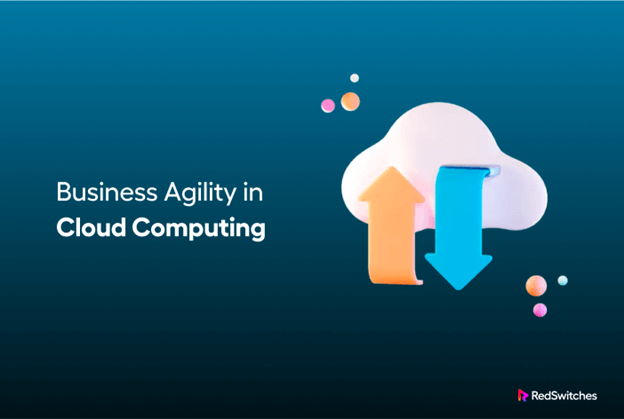Did you know that business agility plays a vital role in cloud adoption? A recent survey showed that at least 32% of the participants cited it as the lead reason for using the cloud. With the complexity of the modern business environment, organizations must be able to navigate them. In these situations, business agility in cloud computing comes handy.
Now, the cloud is flexible, offering businesses the agility they need to succeed. Businesses can take advantage of it in product launches since it provides scalability, among other things. That’s how they can cut expenses, collaborate better and adjust their operations.
Now you may ask, how can the cloud bring business agility? This guide will examine the core principles of business agility, benefits and challenges to cloud architecture. In addition, we’ll explore practical examples of how businesses can implement cloud agility.
Table of Content
- What Is Cloud Computing In Business Agility?
- Types Of Agility In the Cloud?
- How Is Cloud Computing Crucial to Business Agility?
- Key Takeaways
- FAQs
What Is Cloud Computing In Business Agility?
Cloud agility is the enhanced ability to stay nimble and depend on cloud flexibility to make your business operations agile. It’s one way that a business can use cloud computing to satisfy customer expectations and evolve.
How Does Cloud Computing Bring Business Agility?
There are several ways in which organizations can achieve agility in business, such as:
- Time to market and swiftness: The cloud is agile enough to offer resources to users through an internet connection. It becomes valuable, especially for businesses that operate in remote areas.
- Fast Innovation: The cloud supports speedy innovation, where it increases product creation and how it gets marketed. This allows the businesses to align their objectives with the operation processes.
- Cutting Costs: The cloud makes its resources accessible through an internet connection. So, setting up an account just takes a few minutes, and you are ready to use the cloud resources. The service provider will bill you for the amount of resources you use. It makes it a cost-effective model, especially for SMEs.
- Business Continuity and Resilience: Business continuity and swift disaster recovery are benefits of using the cloud. It means in case of a natural disaster. Companies can recover their data fast, lowering downtime and ensuring the continuity of business operations.
- Partnership and Accessibility: Using the cloud helps organizations to combine and collaborate workforce in remote locations. Leveraging cloud tools enables businesses to work in distributed environments, boosting productivity and agility.
When companies incorporate business agility in cloud computing, they can thrive in the marketplace, edging out competition.
Types Of Agility In the Cloud?
There are several types of agility in cloud computing, and they include:
1. Engineering Resource Availability
It is a resource in cloud computing whose primary focus is the management and allocation of computing resources for engineering. The good thing is service providers provide APIs that help the engineers gain access and scale the resources. A good example is networking, virtual machines, and bandwidth.
Improved workforce collaboration, swift testing, development, and optimized resource usage result from agility. Businesses should remember that agility cannot reduce the time for an application supply chain. However, agility can help enhance IT operations. The chain starts from the prototype to the production rollout.
2. Business Response to Change Conditions or Opportunities
This type of agility focuses on how organizations respond swiftly to the evolving market environment. Since one of the significant benefits of cloud computing is scalability, it helps companies scale their resources on demand. In addition, it enables organizations to launch new apps and customize their products to the market changes with agility.
Overall, these two agility types offer unique benefits. Engineering resource availability improves IT processes internally. The business’s response to change conditions also helps companies respond fast to market changes. Therefore, utilizing the cloud can enable businesses to gain from both agilities. In addition, it opens new opportunities for businesses in their operations and growth.
How Is Cloud Computing Crucial to Business Agility?
The cloud is driving business agility in the marketplace. In addition, it packs many benefits which can help businesses become agile and adapt to the environment. Here are ways they can accomplish it:
1. Data Availability
The cloud is flexible, and a user can access the cloud resources even remotely with an internet connection. Businesses that work in those remote areas will find it helpful since they can collaborate better with their mobile teams.
2. Reduces Business Complexity
The cloud is agile, and the good thing is that a user can scale the resources on demand. It reduces the need to keep requesting the service provider add more resources. This approach can help businesses scale their operations and thrive.
3. Automation
It is a valuable feature because it helps cloud admins automate manual processes, which speeds resource delivery on demand. The good thing about automation is it helps reduce errors and cuts expenses.
4. Less Infrastructural Maintenance
A service provider owns and maintains the cloud infrastructure that customers use. It helps companies have fewer infrastructure responsibilities like maintenance and much more. So, businesses get the privilege to focus on core business operations.
5. Increased Up-Time
The cloud offers reliability which can be a benefit to companies. They can use it to provide their services and apps with 24/7 up-time. Leveraging the cloud helps companies reduce downtime and have operation consistency even in peak hours. It can result in higher revenues and satisfied customers.
6. Focuses and Optimizes IT Strategies
The cloud can help businesses eliminate resource wastage by picking the right size of resources needed. Not only that, a good cloud strategy can help businesses see what they need to improve on.
7. Enables On-Demand Resources for Development and Testing
It’s common to find most of the cloud on-demand services user-friendly. It can help businesses to add more resources without the need to contact the service provider.
8. Rapid Innovation
Modernization brings innovation, and the cloud can open up opportunities for companies to access AI, big data analytics, IoT and ML. Application of these technologies can be the best bet for new companies to nurture product development.
9. Adaptive Auto Scaling
The cloud can offer auto-adaptive scaling to businesses. The good thing is businesses can automate it. The nature of this auto-adaptive scaling feature lets companies scale their infrastructure without hiccups.
A good example is during peak hours; a company can distribute extra resources to cope with traffic spikes. On the other hand, they can reduce resource use when there is no considerable demand. It’s a feature of the cloud that makes it easy for users to achieve their objectives.
10. Flexibility
It’s another cloud feature companies can use to gain an edge in the marketplace. Companies don’t have to worry about investing in expensive hardware. They can install new virtual machines and launch new apps and provide bandwidth.
Key Takeaways
- In today’s business landscape, understanding business agility benefits and challenges to cloud architecture is crucial. It can help companies respond well to customer expectations.
- The cloud is agile; the best part is that companies can use it to scale. It’s one way businesses can meet their goals and succeed.
- The cloud offers many benefits businesses can use to grow and deliver services that satisfy their customers.
- The cloud is flexible, enabling swift app deployment with no hardware and facilitating agile processes.
- Cloud security provided by service providers is robust. You don’t have to worry about breaches since they employ measures to ensure data privacy.
- Cloud computing offers businesses a wide range of resources and services to explore and leverage.
Don’t forget to check our resources section to learn more about business agility in cloud computing. It’s time businesses adopt cloud computing to stay ahead of the competition in a cut-throat marketplace.
FAQs
What Is Agility in Cloud Computing?
It is the ability of a business to respond and grow in an evolving market. This means the organization must be reliable, adaptable, and customer-centered to meet current market conditions.
What Is an Example of Agility in the Cloud?
Scalability in the provision of resources is an excellent example of agility. Here is a scenario: For a business to deal with high volumes of online traffic, it can install different virtual machines during peak hours. On the other hand, it can reduce their size during low-traffic hours.
What Are the Principles of Business Agility?
There are several principles, but the main one is the guiding theory that businesses can emulate to adapt to the ever-changing market conditions. Some common ones are flexibility, transparency, modernization, partnership, and more.
Why Is Cloud Agile?
There are several reasons why the cloud is agile. Some of which are flexibility, collaboration tools, scalability, and more. The best part about these features is that they help businesses evolve to market conditions and cut down on operational costs.


